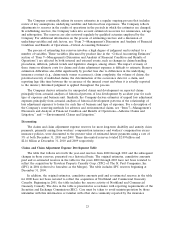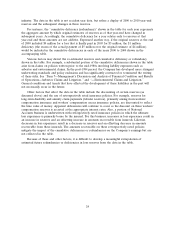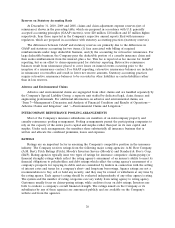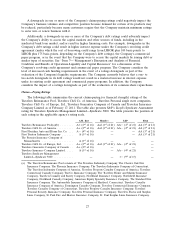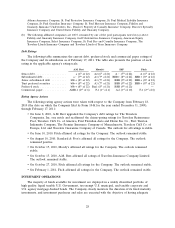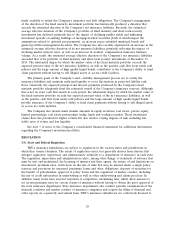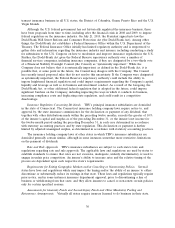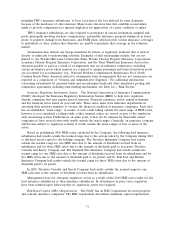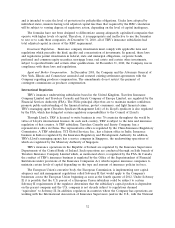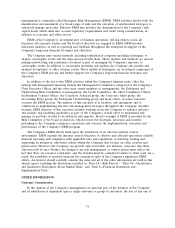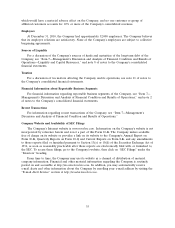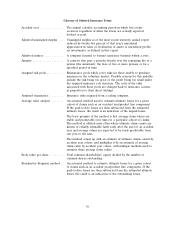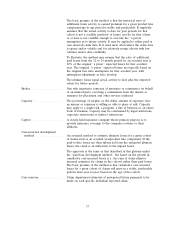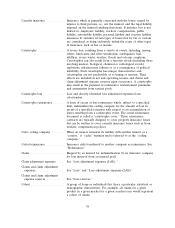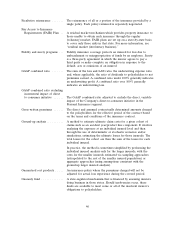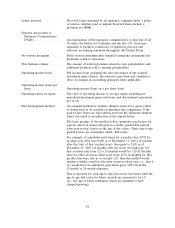Travelers 2010 Annual Report Download - page 44
Download and view the complete annual report
Please find page 44 of the 2010 Travelers annual report below. You can navigate through the pages in the report by either clicking on the pages listed below, or by using the keyword search tool below to find specific information within the annual report.and is intended to raise the level of protection for policyholder obligations. Under laws adopted by
individual states, insurers having total adjusted capital less than that required by the RBC calculation
will be subject to varying degrees of regulatory action, depending on the level of capital inadequacy.
The formulas have not been designed to differentiate among adequately capitalized companies that
operate with higher levels of capital. Therefore, it is inappropriate and ineffective to use the formulas
to rate or to rank these companies. At December 31, 2010, all of TRV’s insurance subsidiaries had
total adjusted capital in excess of the RBC requirement.
Investment Regulation. Insurance company investments must comply with applicable laws and
regulations which prescribe the kind, quality and concentration of investments. In general, these laws
and regulations permit investments in federal, state and municipal obligations, corporate bonds,
preferred and common equity securities, mortgage loans, real estate and certain other investments,
subject to specified limits and certain other qualifications. At December 31, 2010, the Company was in
compliance with these laws and regulations.
Agent and Broker Compensation. In December 2010, the Company and the Attorneys General of
New York, Illinois and Connecticut amended and restated existing settlement agreements with the
Company regarding producer compensation. The amendments do not restrict the payment of
contingent commissions as producer compensation.
International Regulation
TRV’s insurance underwriting subsidiaries based in the United Kingdom, Travelers Insurance
Company Limited and Travelers Casualty and Surety Company of Europe Limited, are regulated by the
Financial Services Authority (FSA). The FSA’s principal objectives are to maintain market confidence,
promote public understanding of the financial system, protect consumers, and fight financial crime.
TRV’s managing agent (Travelers Syndicate Management Ltd.) of its Lloyd’s syndicate is also regulated
by the FSA, which has delegated certain regulatory responsibilities to the Council of Lloyd’s.
Through Lloyd’s, TRV is licensed to write business in over 70 countries throughout the world by
virtue of Lloyd’s international licenses. In each such country, TRV is subject to the laws and insurance
regulation of that country. A TRV subsidiary, Travelers Casualty and Surety Company, has a
representative office in China. The representative office is regulated by the China Insurance Regulatory
Commission. A TRV subsidiary, TCI Global Services, Inc., has a liaison office in India. Insurance
business in India is regulated by the Insurance Regulatory and Development Authority. In addition,
TRV’s Lloyd’s managing agency has a service company in Singapore, the underwriting operations of
which are regulated by the Monetary Authority of Singapore.
TRV’s insurance operations in the Republic of Ireland are regulated by the Insurance Supervision
Departments of the Central Bank of Ireland. Such operations are conducted through an Irish branch of
Travelers Insurance Company Limited which, as mentioned above, is regulated by the FSA. In Canada,
the conduct of TRV’s insurance business is regulated by the Office of the Superintendent of Financial
Institutions under provisions of the Insurance Companies Act, which requires insurance companies to
maintain certain levels of capital depending on the type and amount of insurance policies in force.
The European Union’s executive body, the European Commission, is implementing new capital
adequacy and risk management regulations called Solvency II that would apply to the Company’s
businesses across the European Union beginning as soon as the fourth quarter of 2012. Under Solvency
II, it is possible that the U.S. parent of a European Union subsidiary could be subject to certain
Solvency II requirements if the regulator determines that the subsidiary’s capital position is dependent
on the parent company and the U.S. company is not already subject to regulations deemed
‘‘equivalent’’ to Solvency II. In addition, regulators in countries where the Company has operations are
working with the International Association of Insurance Supervisors (and in the U.S., with the National
32



